Not quite The Commons; next door in Westminster Hall actually
Diaspora Tapestry's first stop back in the UK lands in Westminster, where Scotland's been a hot topic all week!
As this week's East Lothian Courier reports, the Diaspora Tapestry's first landfall in Scotland will be its exhibition throughout the 3Harbours in Prestonpans Community Centre. It's twice as large as it was last time it was there for launch 3 years ago now with 305 panels + 5 extras from Iceland.
Before then however, it's being hosted by the Crown Court Church in London with # 10 Downing Street's many Scottish Occupants an additional feature! [see below] And as our header here corrects, it's not in The Commons but the adjacent Westminster Hall opening today 20th March for 6 weeks till April 29th [Entry best 10/ 4pm; closed Sundays and Bank Holidays].
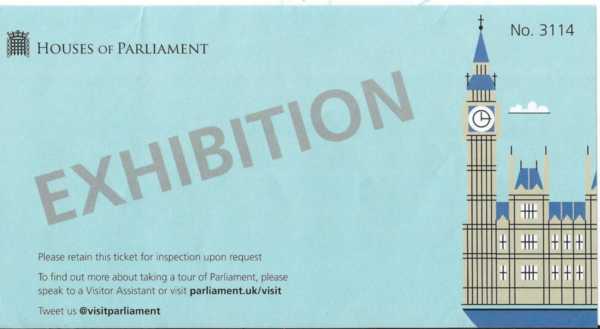
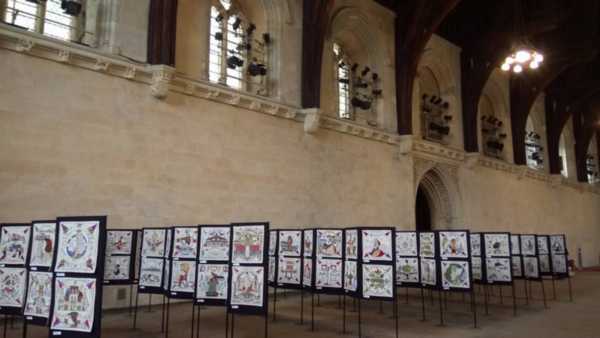
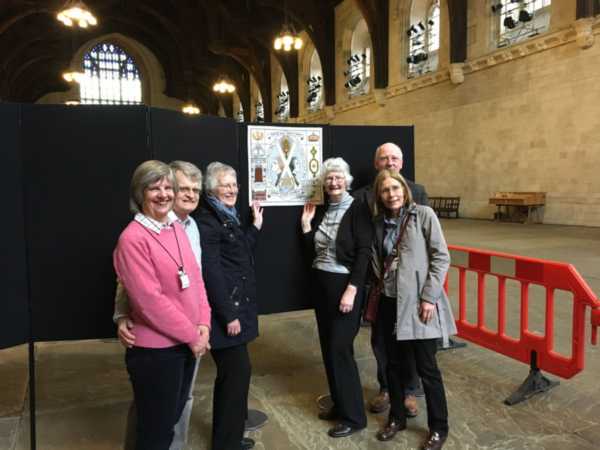
The Hall's a grand space, lofty and with the most majestic hammer head roof beams. The Crown Court Church Team led by Sheila Haddon set to work with gusto after Arran Johnson arrived in the orange Prestonpans Tapestry [the 'other' one] van at the east door; within two hours all was well in place. Here they are standing proudly next to their own panel.
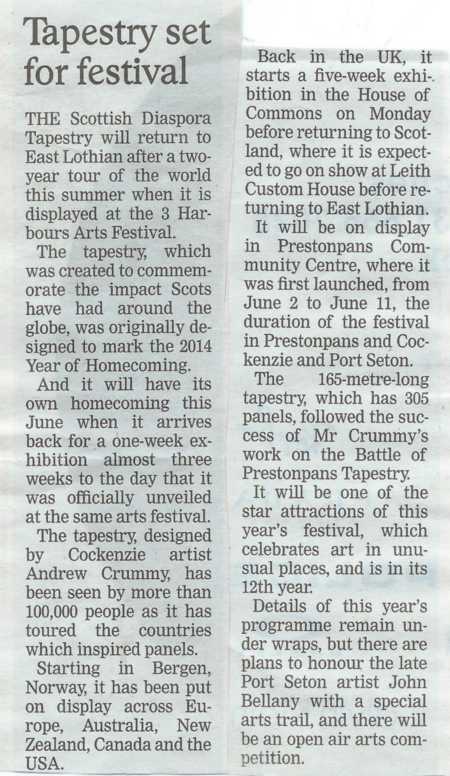
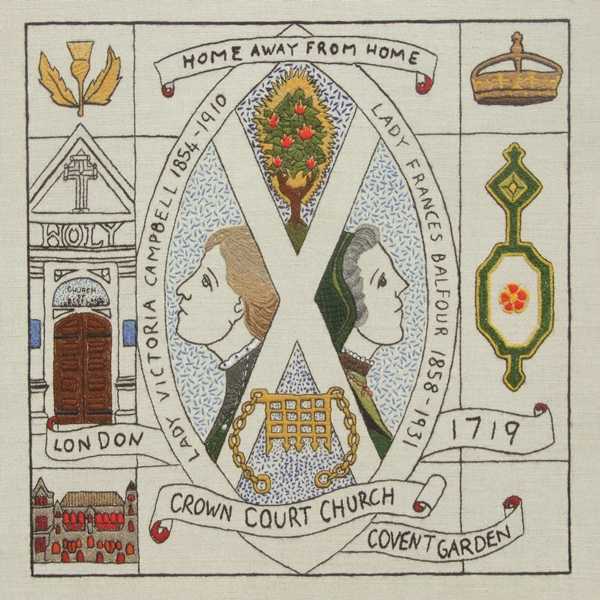
Stitchers: Sheila Haddon, Janet Dowswell, Christine Ward, Elizabeth Chestnut, Jennifer Laird, Sheena Tait, Elizabeth Steel, Linda Mjcher, Alison Dartnell .
In days gone by, before the Union of the Crowns in 1603, Scotland maintained an embassy in London roughly where Northumberland Avenue is now. There was a small church there, used by visitors and embassy staff, which maintained the Scottish style of worship. When King James VI of Scotland ascended the English throne in 1603 the embassy, now redundant, was closed, but the church was greatly enlarged due to the influx of Scottish courtiers accompanying the king. The congregation continued to worship on the old embassy site until, towards the end of the seventeenth century, a disastrous fire, which destroyed everything around Northumberland Avenue, caused them to become peripatetic for a time. Records show that they were meeting in Upper St. Martin’s Lane in 1711 and, by now known as the Kirk of the Crown of Scotland, settled on the present Crown Court site, just off Drury Lane, in 1718. There they built a new church which opened the following year. Thus matters continued for another century and a half or more, until, come the latter part of the nineteenth century, the church building had become dilapidated and indeed the whole Drury Lane area had become very run down. In 1881 a new minister was called on the tacit understanding that a new church would be built in a more salubrious and convenient part of the town. This was duly done, and St. Columba’s, Pont Street, Chelsea, was the result, whither the congregation moved, lock, stock and barrel in 1884. Except that, congregations then being not terribly dissimilar to congregations now, not everybody went. Some remained, and eventually, thanks to the energy and dedication – not to mention the generosity – of many people, particularly the daughters of the 8th Duke of Argyll, Lady Frances Balfour and Lady Victoria Campbell, the present building was erected in 1909. It is worth remembering that when the original church was built in 1719 it was not long after the Jacobite rebellion of 1715, and indeed there was another, albeit a lesser, uprising in 1718. As a Scot in London at that time, it would therefore have been important to show which side you were on, hence the emphasis in the church on their links to what was now the Hanoverian succession, with its Scottish roots stemming directly from King James VI and I. When the church was rebuilt in 1909, the Campbells were very much involved, and as the Campbells were never noted for their Jacobite sympathies – quite the reverse, in fact – the Hanoverian associations were not forgotten, with the result that we now have the magnificent Royal Coat of Arms on the back wall of the church. The present congregation, mainly Scottish or of Scottish extraction, but with a good number of Presbyterians from elsewhere, is lively and friendly, with an active Rambling and Social Club, Sunday School, choir and Guild – one of the oldest branches in the Kirk. It is a little bit of Scotland, found in Covent Garden, the heart of central London.
Eaglais na h-Alba ann an Cùirt a’ Chrùin
Ro 1603 bha eaglais bheag aig ambasaid na h-Alba ann an Lunnainn, air a dèanamh nas motha às dèidh Aonadh nan Crùn do luchd-cùirte Albannach. Chaidh a sgrios le teine ach thuinich an coitheanal taistealch air làrach Cùirt a’ Chrùin dheth Leàna Drury ann an 1718. Dh’fhosgail eaglais ùr a’ bhliadhna às dèidh sin, ach ro dheireadh an 19mh linn bha i air a dhol bhuaithe. Ann an 1884 chaidh eaglais ùr (Eaglais Naomh Chaluim Chille ann an Chelsea) a thogail, ach cha robh an coitheanal uile airson gluasad agus chaidh togalach ùr a thogail ann an 1909 dhaibhsan a dh’fhuirich. San latha an-diugh tha e mar phàirt bheag de dh’Alba a tha ri fhaotainn ann an teis-meadhain Lunnainn.
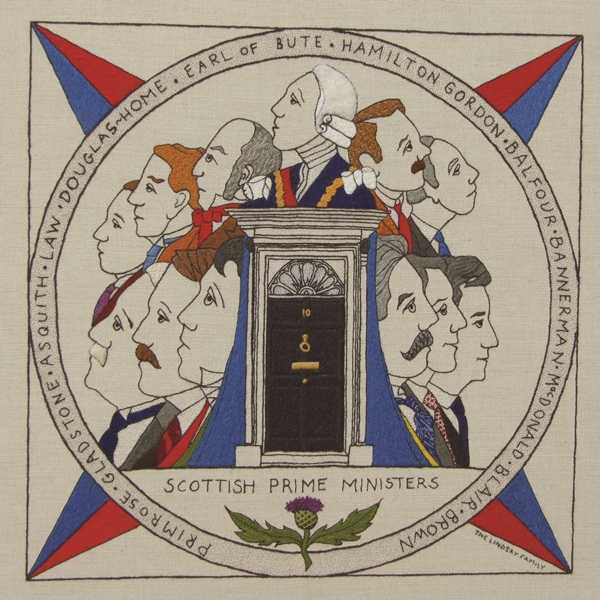
Stitcher: Gill Lindsay (Northampton)
Since the Jacobite Rising of 1745 no fewer than ten Scots, seven actually born in Scotland, have held office as Prime Minister. The first was the Earl of Bute (1762), followed by the Earl of Aberdeen, Earl of Roseberry, Arthur Balfour, Henry Campbell-Bannerman, Andrew Bonar Law, Ramsay MacDonald, Alec Douglas-Home, Tony Blair, and then Gordon Brown in 2007. Such disproportionate representation at Westminster (compared with Wales, Ireland and England) clearly reflects a determination to ensure Scotland played a leading role in the Union and Empire. William Gladstone and Herbert Asquith also sat for Scottish constituencies whilst holding office at 10 Downing Street.
Prìomh Mhinistearan Albannach
Bho àm Ar-a-Mach nan Seumasach ann an 1745, chan eil nas lugha na deichnear Albannach le seachd dhiubh air am breith ann an Alba, air dreuchd a’ Phrìomh Mhinisteir a ghleidheadh. B’ e Iarla Bhòid (1762) a’ chiad fhear dhiubh air a leantainn le Iarla Obar Dheathain, Iarla Roseberry, Artair Balfour, Eanraig Caimbeul-Mac Ille na Brataich, Anndra Bonar Law, Ramsay MacDhòmhnaill, Ailig Dùbhghlas-Home, Tònaidh Blair, agus an uair sin Gòrdan MacIlleDhuinn ann an 2007. Tha a leithid sin de riochdachadh mìchuimseach ann an Westminster (ann an coimeas ris a’ Chuimrigh, Èirinn agus Sasainn) a’ nochdadh gu soilleir dealas a thaobh a dhèanamh cinnteach gum biodh a h-àite fhèin aig Alba aig toiseach gnothaich anns an Aonadh agus Ìmpireachd. Shuidh Uilleam Gladstone agus Herbert Asquith cuideachd airson roinneantaghaidh ann an Alba fhad ’s a bha dreuchd aca aig 10 Sràid Downing.
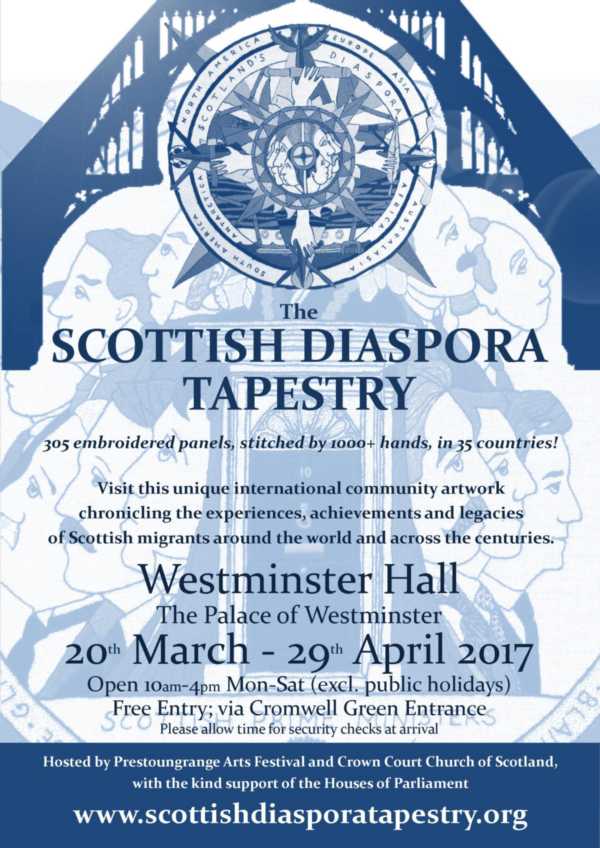
_________________________________________________________
Ed. Gill Lindsay, who stitched the #10 Downing Street panel above has been enlisted for a new panel telling the story of US Presidents, most lately Donald Trump, with Scottish ancestors. Trump's mother was from Scotland and spoke Gaelic all her life. Gill is pictured here below at the Westminster Hall exhibition, at work with that new panel.
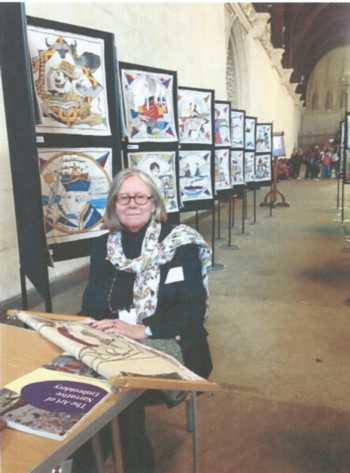
Published Date: March 20th 2017
|





